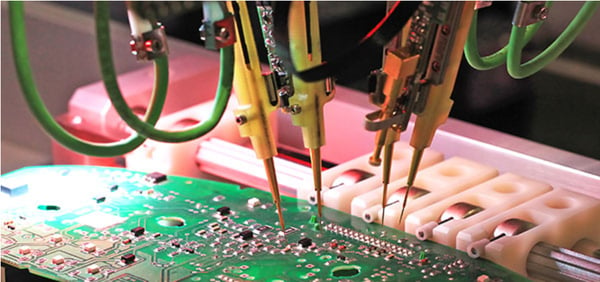Flying Probe Testing 101: A Guide to Reliable PCB Testing
PCB design can be challenging. The complexity of your project and the potential consequences of PCB failure may require thorough, high-level testing...
Deciding on the best testing method for your printed circuit board can be a daunting task. There are plenty of factors to take into consideration, including costs, coverage, and development lead time. However, there are two popular test strategies you’ll often find yourself choosing between: ICT testing vs flying probe testing.
Which of the two is a better automation test solution to fully inspect whether your specific product will perform well in the market? Would it be wise to use a combination of both to achieve the desired test coverage? How complex is your design, and would it be better to consult a contract manufacturer who can offer an array of test options beyond just these two?
All these are questions you should ask yourself. Discuss your options with your electronics manufacturer, too. Each option has its strengths and weaknesses, and your contract manufacturer can help you settle on the best one by analyzing each test’s:
In-circuit testing (ICT) and flying probe testing (FPT) offer similar coverage in their tests, discovering most manufacturing defects that often occur in printed circuit boards (PCBs). These include:
The two, however, differ on their:
ICT is a powerful tool for PCB testing. It uses bed of nails in-circuit test gear to access the circuit nodes of a board and check the performance of each component. It can also test some functionality of digital circuits, although the complexity involved can make it economically prohibitive.
ICT is most suitable for testing products that are more developed and high-volume. However, the up-front costs and development lead time with ICT are higher and longer, respectively, than those of flying probe testing (FPT). This is because your manufacturer must explicitly create a custom ICT fixture for each PCB.
The good thing with ICT is that after the tool is developed, costs per unit tend to be lower than with FPT because it only takes about 1 minute for one test cycle. With FPT, it can take up to 15 minutes per board.

(Photo courtesy Doxals)
Unlike an ICT machine, an FPT does not utilize a bed of nails fixture. Instead, it uses a small number of movable and fixed probes to easily make a simultaneous in-circuit test of the top and bottom of your PCB. This can also be simply called a flying probe tester. It’s made up of high-precision needles -- some machines use as few as four needles, while others can use as many as 20 per PCB side. They’re programmed to contact component pins and perform electrical and functional tests to determine if the board is fit for the field.
FPT is most suitable for products that are in the early stages of development and are low-volume orders. It requires no custom tooling, and customization for each PCB is carried out through programming using the CAD data you provide to the manufacturer. With FPT, costs-per-unit are higher compared to ICT because of longer test cycle time periods per test system (up to 15 minutes).
All in all, the choice between ICT and FPT will depend on several important factors of your project. To recap, these include:
Remember to consult a well-rounded contract manufacturer for professional guidance. There may be other PCB testing and inspection options that are better suited to your design. Learn about those other options with our free guide to PCB testing!

PCB design can be challenging. The complexity of your project and the potential consequences of PCB failure may require thorough, high-level testing...

Electronics manufacture and testing are like squabbling siblings. PCB testing is a necessary expense that, when done correctly, prevents much larger...

PCB contamination testing is not for every project, but it’s a lifesaver for some.